Vehicle Maths 3 Assignment 2
VerifiedAdded on 2023/06/11
|7
|938
|206
AI Summary
This assignment for Vehicle Maths 3 covers topics such as inverse trigonometrical ratios, non right-angled and complex triangles, the Sine Rule, the Cosine Rule, engine stroke, connecting rod, and more.
Contribute Materials
Your contribution can guide someone’s learning journey. Share your
documents today.
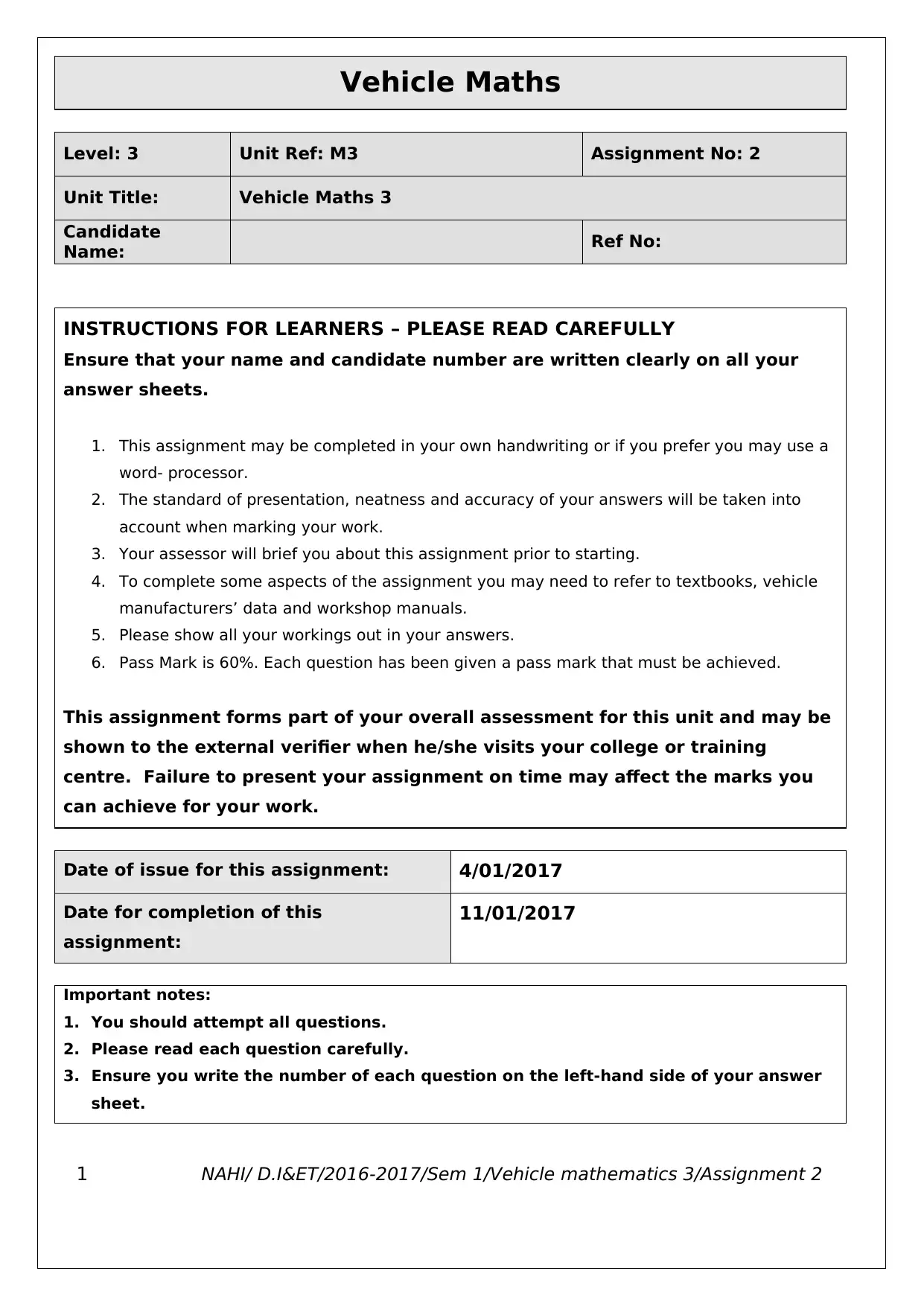
Vehicle Maths
Level: 3 Unit Ref: M3 Assignment No: 2
Unit Title: Vehicle Maths 3
Candidate
Name: Ref No:
INSTRUCTIONS FOR LEARNERS – PLEASE READ CAREFULLY
Ensure that your name and candidate number are written clearly on all your
answer sheets.
1. This assignment may be completed in your own handwriting or if you prefer you may use a
word- processor.
2. The standard of presentation, neatness and accuracy of your answers will be taken into
account when marking your work.
3. Your assessor will brief you about this assignment prior to starting.
4. To complete some aspects of the assignment you may need to refer to textbooks, vehicle
manufacturers’ data and workshop manuals.
5. Please show all your workings out in your answers.
6. Pass Mark is 60%. Each question has been given a pass mark that must be achieved.
This assignment forms part of your overall assessment for this unit and may be
shown to the external verifier when he/she visits your college or training
centre. Failure to present your assignment on time may affect the marks you
can achieve for your work.
Date of issue for this assignment: 4/01/2017
Date for completion of this
assignment:
11/01/2017
Important notes:
1. You should attempt all questions.
2. Please read each question carefully.
3. Ensure you write the number of each question on the left-hand side of your answer
sheet.
1 NAHI/ D.I&ET/2016-2017/Sem 1/Vehicle mathematics 3/Assignment 2
Level: 3 Unit Ref: M3 Assignment No: 2
Unit Title: Vehicle Maths 3
Candidate
Name: Ref No:
INSTRUCTIONS FOR LEARNERS – PLEASE READ CAREFULLY
Ensure that your name and candidate number are written clearly on all your
answer sheets.
1. This assignment may be completed in your own handwriting or if you prefer you may use a
word- processor.
2. The standard of presentation, neatness and accuracy of your answers will be taken into
account when marking your work.
3. Your assessor will brief you about this assignment prior to starting.
4. To complete some aspects of the assignment you may need to refer to textbooks, vehicle
manufacturers’ data and workshop manuals.
5. Please show all your workings out in your answers.
6. Pass Mark is 60%. Each question has been given a pass mark that must be achieved.
This assignment forms part of your overall assessment for this unit and may be
shown to the external verifier when he/she visits your college or training
centre. Failure to present your assignment on time may affect the marks you
can achieve for your work.
Date of issue for this assignment: 4/01/2017
Date for completion of this
assignment:
11/01/2017
Important notes:
1. You should attempt all questions.
2. Please read each question carefully.
3. Ensure you write the number of each question on the left-hand side of your answer
sheet.
1 NAHI/ D.I&ET/2016-2017/Sem 1/Vehicle mathematics 3/Assignment 2
Secure Best Marks with AI Grader
Need help grading? Try our AI Grader for instant feedback on your assignments.
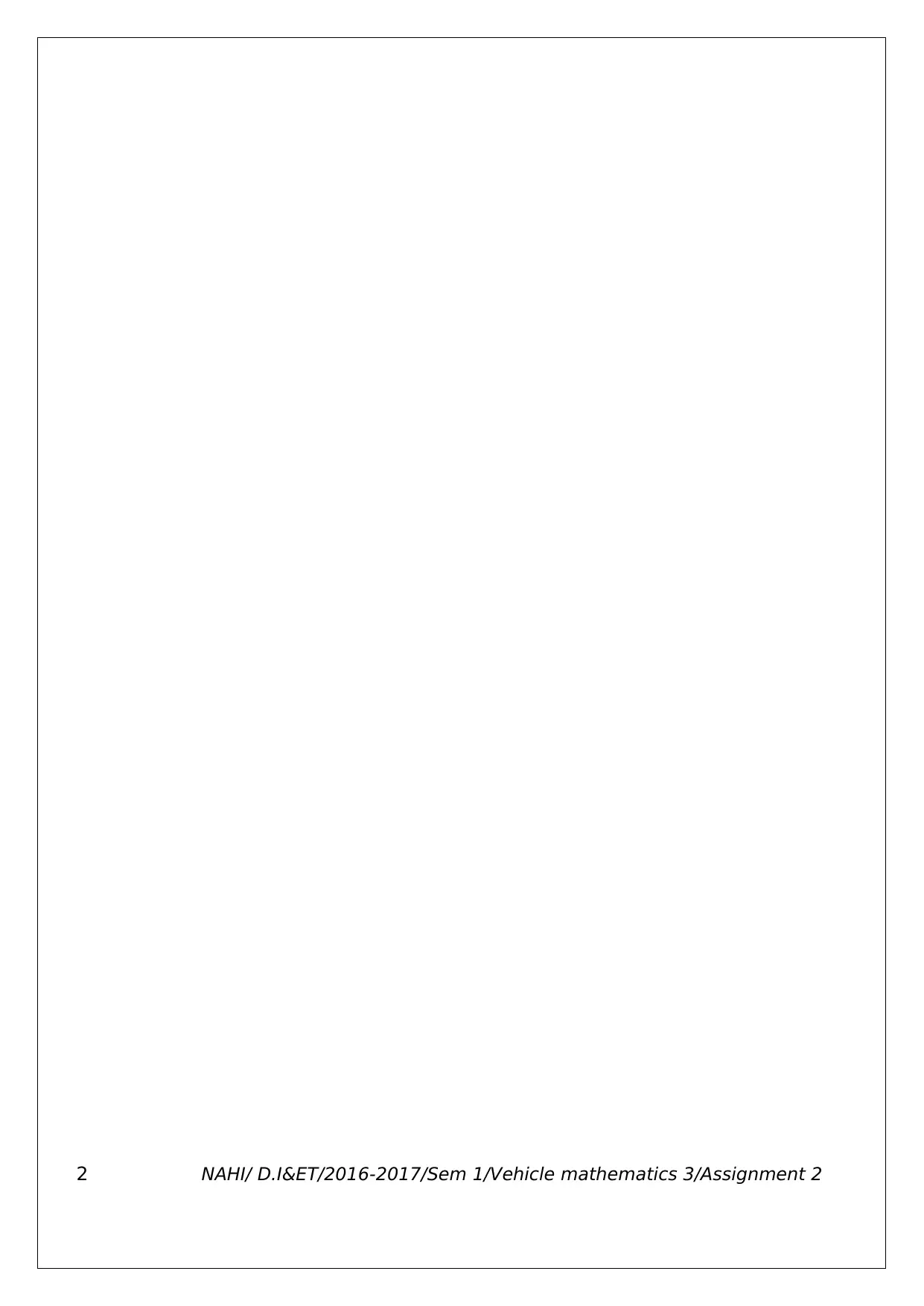
2 NAHI/ D.I&ET/2016-2017/Sem 1/Vehicle mathematics 3/Assignment 2
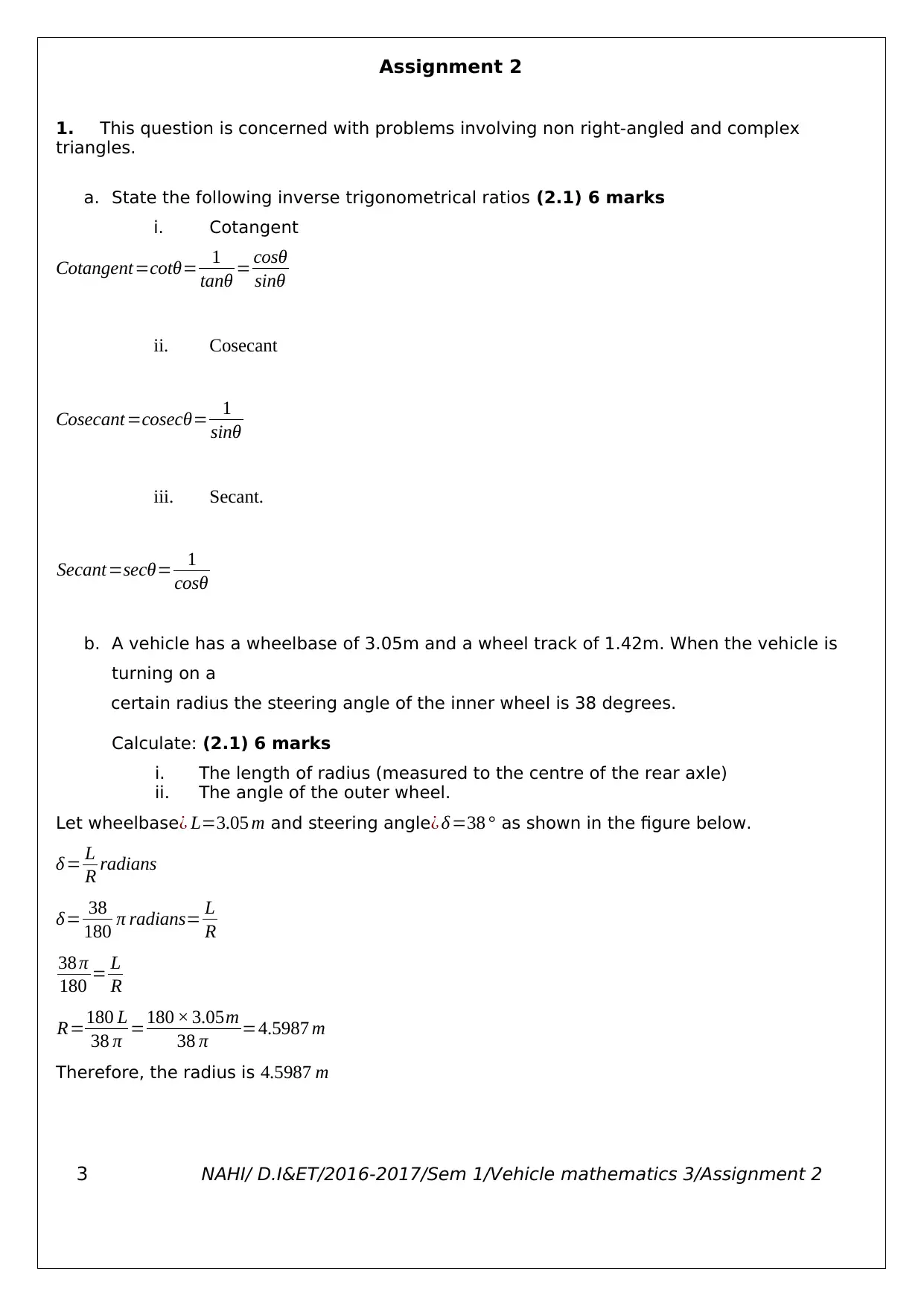
Assignment 2
1. This question is concerned with problems involving non right-angled and complex
triangles.
a. State the following inverse trigonometrical ratios (2.1) 6 marks
i. Cotangent
Cotangent=cotθ= 1
tanθ = cosθ
sinθ
ii. Cosecant
Cosecant =cosecθ= 1
sinθ
iii. Secant.
Secant=secθ= 1
cosθ
b. A vehicle has a wheelbase of 3.05m and a wheel track of 1.42m. When the vehicle is
turning on a
certain radius the steering angle of the inner wheel is 38 degrees.
Calculate: (2.1) 6 marks
i. The length of radius (measured to the centre of the rear axle)
ii. The angle of the outer wheel.
Let wheelbase ¿ L=3.05 m and steering angle¿ δ=38 ° as shown in the figure below.
δ = L
R radians
δ= 38
180 π radians= L
R
38 π
180 = L
R
R=180 L
38 π =180 × 3.05m
38 π =4.5987 m
Therefore, the radius is 4.5987 m
3 NAHI/ D.I&ET/2016-2017/Sem 1/Vehicle mathematics 3/Assignment 2
1. This question is concerned with problems involving non right-angled and complex
triangles.
a. State the following inverse trigonometrical ratios (2.1) 6 marks
i. Cotangent
Cotangent=cotθ= 1
tanθ = cosθ
sinθ
ii. Cosecant
Cosecant =cosecθ= 1
sinθ
iii. Secant.
Secant=secθ= 1
cosθ
b. A vehicle has a wheelbase of 3.05m and a wheel track of 1.42m. When the vehicle is
turning on a
certain radius the steering angle of the inner wheel is 38 degrees.
Calculate: (2.1) 6 marks
i. The length of radius (measured to the centre of the rear axle)
ii. The angle of the outer wheel.
Let wheelbase ¿ L=3.05 m and steering angle¿ δ=38 ° as shown in the figure below.
δ = L
R radians
δ= 38
180 π radians= L
R
38 π
180 = L
R
R=180 L
38 π =180 × 3.05m
38 π =4.5987 m
Therefore, the radius is 4.5987 m
3 NAHI/ D.I&ET/2016-2017/Sem 1/Vehicle mathematics 3/Assignment 2
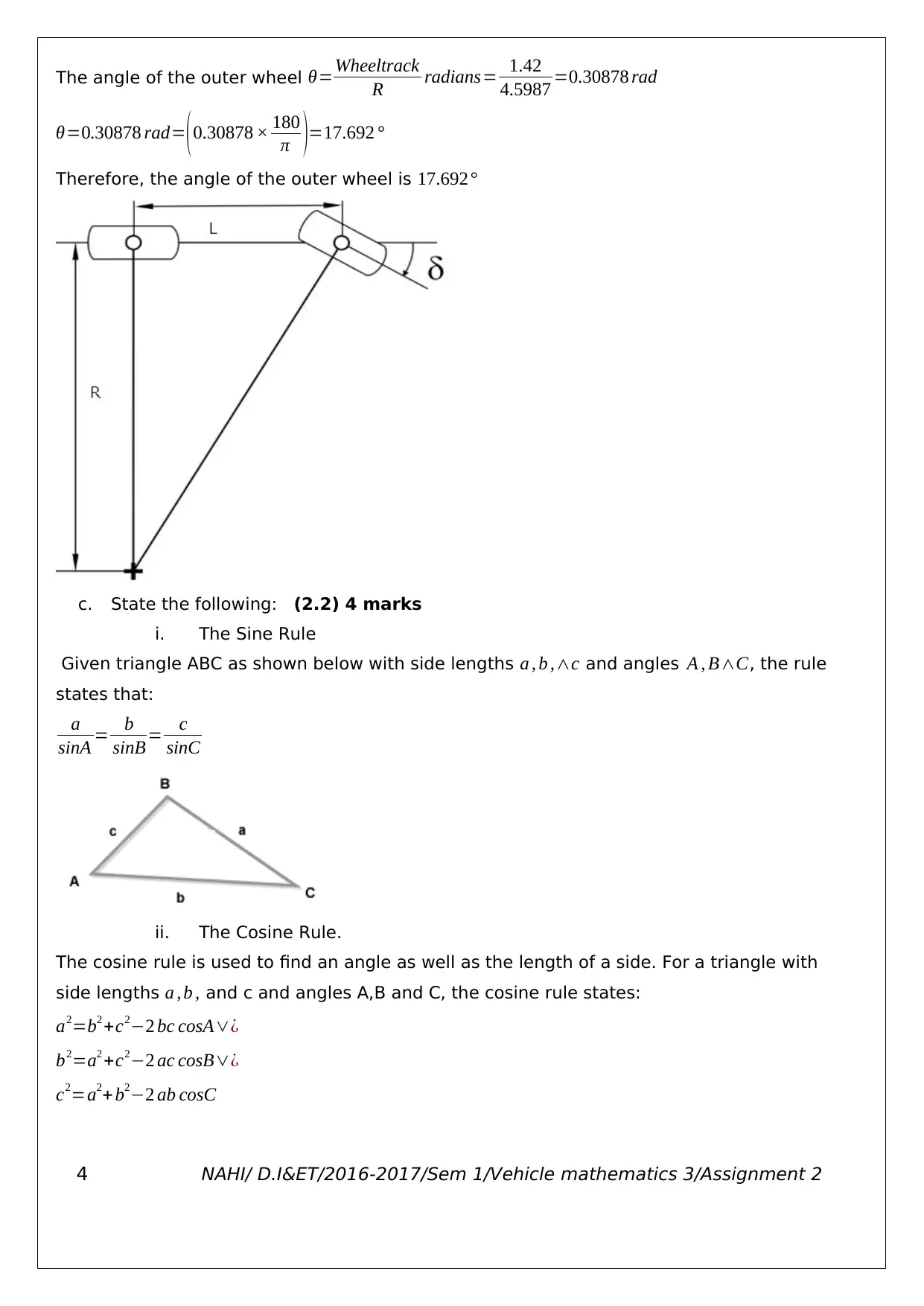
The angle of the outer wheel θ=Wheeltrack
R radians= 1.42
4.5987 =0.30878 rad
θ=0.30878 rad= ( 0.30878 × 180
π )=17.692 °
Therefore, the angle of the outer wheel is 17.692°
c. State the following: (2.2) 4 marks
i. The Sine Rule
Given triangle ABC as shown below with side lengths a , b ,∧c and angles A , B∧C, the rule
states that:
a
sinA = b
sinB= c
sinC
ii. The Cosine Rule.
The cosine rule is used to find an angle as well as the length of a side. For a triangle with
side lengths a , b , and c and angles A,B and C, the cosine rule states:
a2=b2 +c2−2 bc cosA∨¿
b2=a2 +c2−2 ac cosB∨¿
c2=a2+ b2−2 ab cosC
4 NAHI/ D.I&ET/2016-2017/Sem 1/Vehicle mathematics 3/Assignment 2
R radians= 1.42
4.5987 =0.30878 rad
θ=0.30878 rad= ( 0.30878 × 180
π )=17.692 °
Therefore, the angle of the outer wheel is 17.692°
c. State the following: (2.2) 4 marks
i. The Sine Rule
Given triangle ABC as shown below with side lengths a , b ,∧c and angles A , B∧C, the rule
states that:
a
sinA = b
sinB= c
sinC
ii. The Cosine Rule.
The cosine rule is used to find an angle as well as the length of a side. For a triangle with
side lengths a , b , and c and angles A,B and C, the cosine rule states:
a2=b2 +c2−2 bc cosA∨¿
b2=a2 +c2−2 ac cosB∨¿
c2=a2+ b2−2 ab cosC
4 NAHI/ D.I&ET/2016-2017/Sem 1/Vehicle mathematics 3/Assignment 2
Secure Best Marks with AI Grader
Need help grading? Try our AI Grader for instant feedback on your assignments.
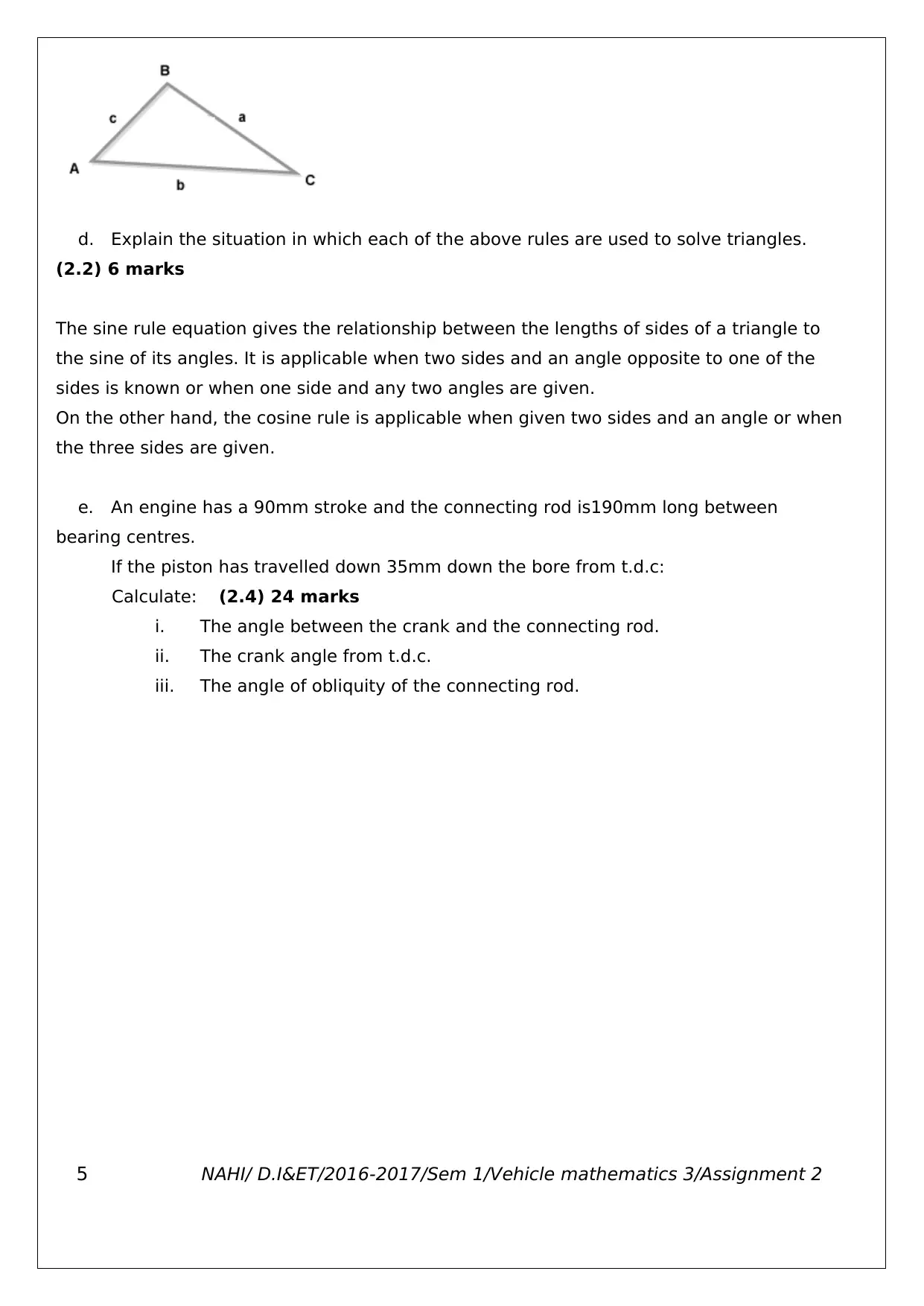
d. Explain the situation in which each of the above rules are used to solve triangles.
(2.2) 6 marks
The sine rule equation gives the relationship between the lengths of sides of a triangle to
the sine of its angles. It is applicable when two sides and an angle opposite to one of the
sides is known or when one side and any two angles are given.
On the other hand, the cosine rule is applicable when given two sides and an angle or when
the three sides are given.
e. An engine has a 90mm stroke and the connecting rod is190mm long between
bearing centres.
If the piston has travelled down 35mm down the bore from t.d.c:
Calculate: (2.4) 24 marks
i. The angle between the crank and the connecting rod.
ii. The crank angle from t.d.c.
iii. The angle of obliquity of the connecting rod.
5 NAHI/ D.I&ET/2016-2017/Sem 1/Vehicle mathematics 3/Assignment 2
(2.2) 6 marks
The sine rule equation gives the relationship between the lengths of sides of a triangle to
the sine of its angles. It is applicable when two sides and an angle opposite to one of the
sides is known or when one side and any two angles are given.
On the other hand, the cosine rule is applicable when given two sides and an angle or when
the three sides are given.
e. An engine has a 90mm stroke and the connecting rod is190mm long between
bearing centres.
If the piston has travelled down 35mm down the bore from t.d.c:
Calculate: (2.4) 24 marks
i. The angle between the crank and the connecting rod.
ii. The crank angle from t.d.c.
iii. The angle of obliquity of the connecting rod.
5 NAHI/ D.I&ET/2016-2017/Sem 1/Vehicle mathematics 3/Assignment 2
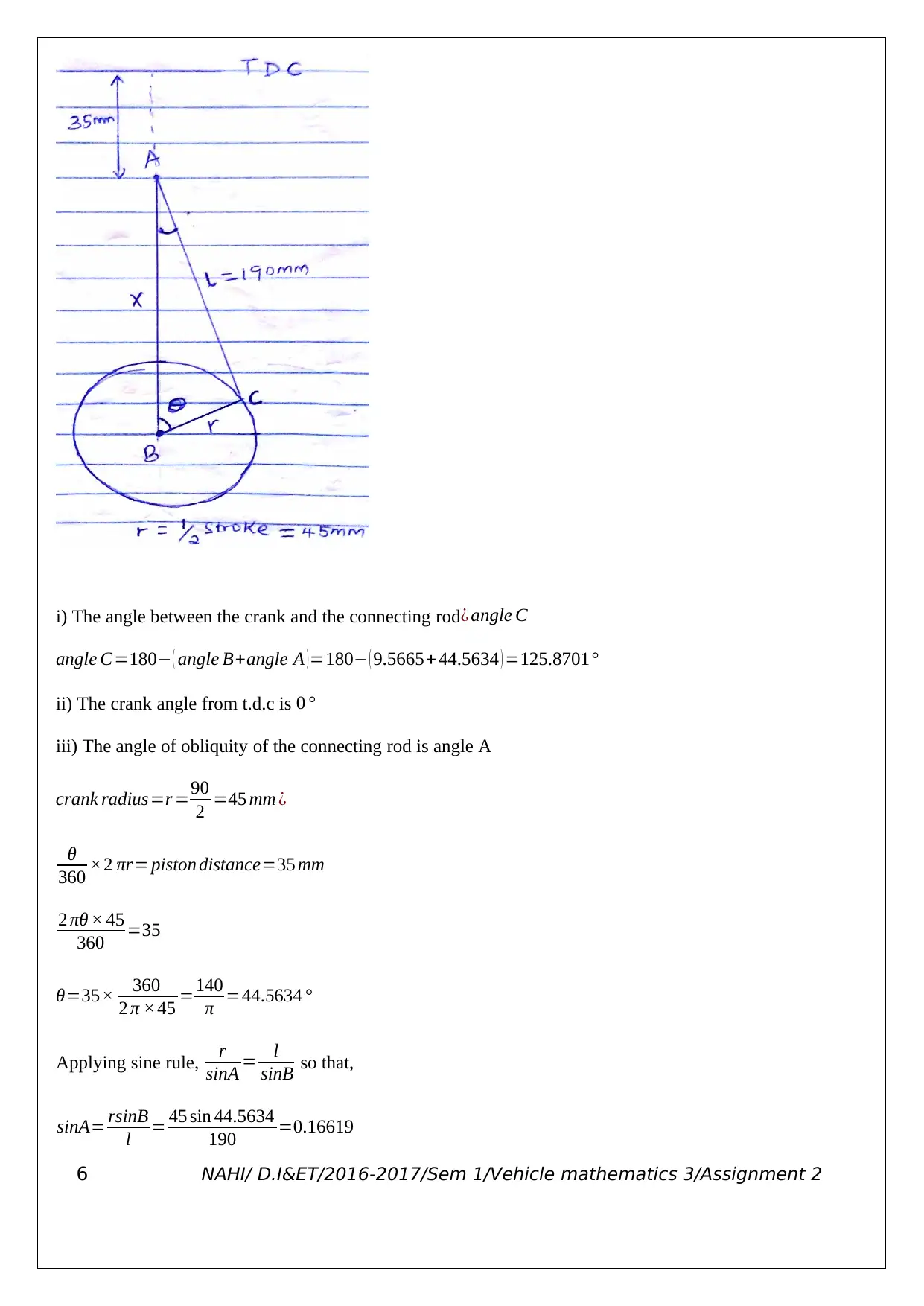
i) The angle between the crank and the connecting rod¿ angle C
angle C=180− ( angle B+angle A )=180− ( 9.5665+ 44.5634 ) =125.8701°
ii) The crank angle from t.d.c is 0 °
iii) The angle of obliquity of the connecting rod is angle A
crank radius=r =90
2 =45 mm ¿
θ
360 ×2 πr= piston distance=35 mm
2 πθ × 45
360 =35
θ=35× 360
2 π ×45 =140
π =44.5634 °
Applying sine rule, r
sinA = l
sinB so that,
sinA= rsinB
l = 45 sin 44.5634
190 =0.16619
6 NAHI/ D.I&ET/2016-2017/Sem 1/Vehicle mathematics 3/Assignment 2
angle C=180− ( angle B+angle A )=180− ( 9.5665+ 44.5634 ) =125.8701°
ii) The crank angle from t.d.c is 0 °
iii) The angle of obliquity of the connecting rod is angle A
crank radius=r =90
2 =45 mm ¿
θ
360 ×2 πr= piston distance=35 mm
2 πθ × 45
360 =35
θ=35× 360
2 π ×45 =140
π =44.5634 °
Applying sine rule, r
sinA = l
sinB so that,
sinA= rsinB
l = 45 sin 44.5634
190 =0.16619
6 NAHI/ D.I&ET/2016-2017/Sem 1/Vehicle mathematics 3/Assignment 2
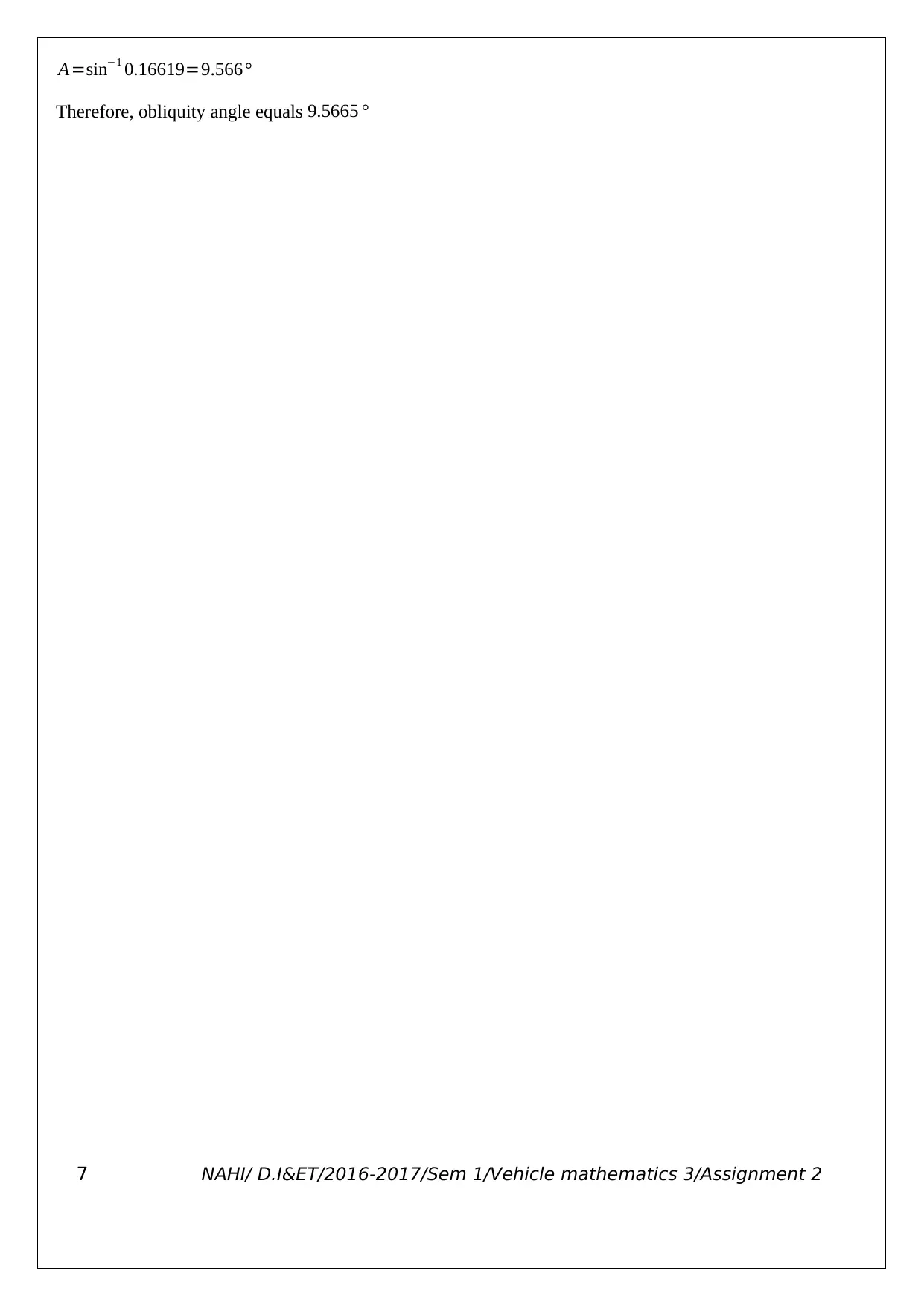
A=sin−1 0.16619=9.566°
Therefore, obliquity angle equals 9.5665 °
7 NAHI/ D.I&ET/2016-2017/Sem 1/Vehicle mathematics 3/Assignment 2
Therefore, obliquity angle equals 9.5665 °
7 NAHI/ D.I&ET/2016-2017/Sem 1/Vehicle mathematics 3/Assignment 2
1 out of 7
Your All-in-One AI-Powered Toolkit for Academic Success.
+13062052269
info@desklib.com
Available 24*7 on WhatsApp / Email
![[object Object]](/_next/static/media/star-bottom.7253800d.svg)
Unlock your academic potential
© 2024 | Zucol Services PVT LTD | All rights reserved.